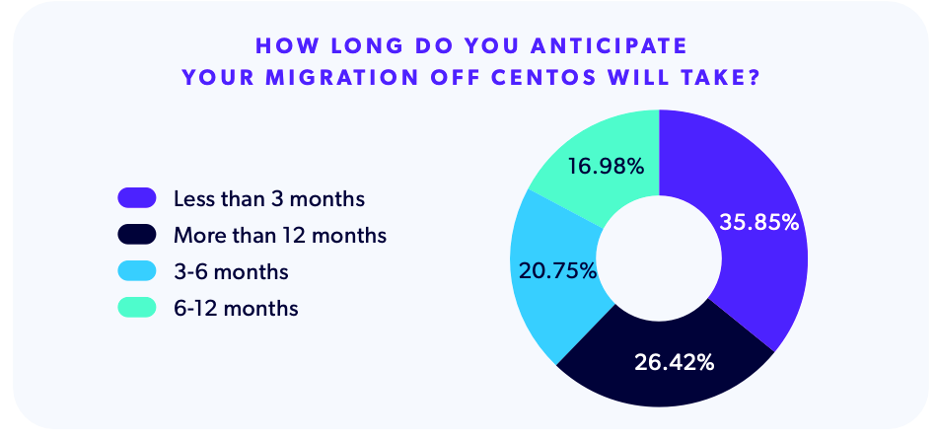Blog
June 26, 2025
The State of Enterprise Linux Distributions After CentOS EOL
Operating Systems
2024 marked a tumultuous year in the world of enterprise Linux distributions. CentOS end of life (EOL) officially arrived in June 2024, marking a pivotal shift for enterprise Linux users. Many migrated to community-supported alternatives (such AlmaLinux and Rocky Linux) which expanded compatibility and cloud support to entice displaced users. Meanwhile, Ubuntu and other major distros continued to roll out new versions and improved hardware support, working to make themselves an attractive destination for those still deploying CentOS.
Given that we are now a year out from CentOS EOL, we were especially interested to examine the 2025 ecosystem to see which enterprise Linux distributions would come out ahead in the State of Open Source Report. Read on to find out which distros grew vs. declined in usage compared to the previous year and what the data suggests about Linux adoption trends in a post-CentOS world.
2025’s Top Enterprise Linux Distributions
In our global survey, we asked respondents to tell us which open source Linux distributions their organizations use, with the understanding that many use more than one. Here’s the breakdown followed by some key takeaways:

Ubuntu Continues as the Top Enterprise Linux Distribution
Similar to previous years’ findings, Ubuntu is the most used enterprise Linux distribution. This remains true regardless of company size and in all regions except Asia, where CentOS is the top distribution (and Ubuntu is tied for second place with Fedora). When segmenting by industry, we found that Ubuntu is also dominant in every sector except for in the banking/finance vertical, where RHEL is more popular, followed by CentOS, and Ubuntu is third.
We suspect that Ubuntu’s continued dominance comes from organizations preferring a stable Linux distribution with strong community support, predictable release schedules, and 5-year term support, which enables future planning.
Back to topSLA-Backed Technical Support for Ubuntu
While Ubuntu remains a free open source project, vendors like OpenLogic offer enterprise-grade 24/7 technical support without the need to purchase a commercial version of Ubuntu and software license.
A Snapshot of CentOS Usage Post-EOL
CentOS reaching EOL in June 2024 was a major event in the Enterprise Linux world, and we were curious to see how usage would be impacted. Here’s what we found:
- CentOS is still the third most used distribution overall — with a nearly identical percentage to 2024.
- 40% of the largest enterprises remain on CentOS.
- While CentOS usage declined in North America and Europe in the past year, other parts of the world (particularly Asia and Latin America) have been slower to migrate to a new distro.
On-Demand Webinar: The State of Open Source in 2025
Discover the latest trends and insights shaping the future of open source in 2025 with our expert-led, on-demand webinar. Watch now to stay ahead in the ever-evolving, post-CentOS landscape.
How Teams Plan to Tackle Newly Discovered CentOS CVEs
We began our follow-up questions by asking survey participants about how they plan to address newly disclosed CentOS vulnerabilities (CVEs).

A CVE impacting your operating system has the potential to cause massive problems and presents significant risk, so it is especially worrisome to see that 38% of survey participants don’t plan to address new CentOS CVEs. When we segment by company size, that number jumps to 38% for the largest enterprises.
While those large enterprise organizations are the most likely to have an LTS vendor, we found that only 25% of them do. Fortunately, only about 11% are taking a head-in-the-sand approach by not scanning or patching CVEs, putting their infrastructure at risk.
Still, we can’t help but wish that number would fall to zero.
The Top Challenge in Managing EOL CentOS Servers
We asked those who were still deploying CentOS at the time of survey about their largest challenges in managing their servers post-EOL. A clear frontrunner quickly emerged.

Unsurprisingly, security patches was the top answer, with more than half of participants citing it. This makes sense in light of the fact that only 13% can patch in-house, and only 19% have an LTS provider to provide ongoing patches. After all, security patch management for users of LTS distributions includes staying on top of what patches have been released, as well as having a deployment plan that includes rollback.
Protect Your Infrastructure With CentOS LTS
Complex enterprise migrations don't happen overnight or without careful planning. By partnering with OpenLogic, you can extend your CentOS 7 runway until 2029, stay secure and compliant, and much more.
Ubuntu is the #1 Migration Destination for CentOS Users
Next, we asked survey participants about where they intend to migrate, now that all CentOS versions have reached end of life.

Again, Ubuntu emerged as the top pick everywhere except in Europe, where 27% of respondents answered “I don’t know,” compared to 18% who selected Ubuntu. While 15% overall said “I don’t know,” interestingly 25% of the largest enterprises gave that response.
But Migrations From CentOS Are Not Without Difficulties
We next examined enterprise Linux users who did successfully complete a migration, asking them to identify how long they estimated that their migration off CentOS would take.

As one might expect, the estimated timelines correlated to company size. Bigger companies, who are likely to have thousands of servers, expected their migrations to take longer.
Anecdotally, we are hearing from our CentOS LTS customers that migrations are proving more complex and taking more time than anticipated, including for smaller businesses with a lower number of servers.
Back to topFinal Thoughts
There’s no question that Linux is the key open source technology that drives the technology landscape; it’s the preferred choice for organizations ranging from small startups to Fortune 500 enterprises. Whether deployed on-premises or in the cloud, Linux powers virtual machines, containers, and serverless architectures. We can see in the horizon that most new technologies — from hardware and IoT to AI and ML — will continue to be based on the Linux operating system.
With CentOS now firmly EOL, and with enterprise Linux distributions continuing to prioritize LTS, it will be interesting to see what trends emerge in the coming year. It's clear that active open source communities and sponsors play a crucial role in shaping the future landscape of Linux choices. With that in mind, we are looking forward to potentially more changes in the Linux space in the coming months, and what next year's State of Open Source Report will reveal.
Enterprise Linux Support Made Easy
OpenLogic provides unbiased guidance, technical and long-term support, and expert migration services to help your team to succeed — no matter the changes or challenges.
Additional Resources
- Solution - Hardened Linux Images for VMs and Containers
- Guide - CentOS EOL Guide for Enterprise
- Datasheet - Enterprise Linux Support and Services
- Blog - Finding the Best Linux Distro for Your Organization
- White Paper - The Decision Maker's Guide to Enterprise Linux
- Blog - Lightweight Linux: Benefits, Use Cases, and Enterprise Considerations
- Blog - The 2025 State of Open Source Report: Trends, Opportunities, and Challenges
- Blog - Rocky Linux vs. AlmaLinux
- Blog - Rocky Linux vs. RHEL
